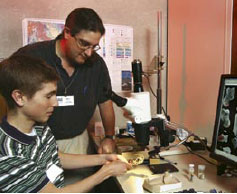“Into Africa” rather than “Out of Africa” could well be the better description of how certain mammals originated and spread across the world, according to a Florida Museum of Natural History scientist, who has found the first evidence for origins in North America of a mammal group thought to be endemic to Africa.
Long considered the cradle of many mammal species, Africa no longer lives up to that image with the discovery in the Wyoming badlands of 54 million-year-old skeletal remains of the first elephant shrew, said Jonathan Bloch, assistant curator of vertebrate paleontology at the Florida Museum of Natural History. Bloch described his team’s finding in the March 24 issue of the journal Nature.

Photo by Kristen Bartlett
“Elephant shrews – part of a group that includes elephants, sea cows and aardvarks, are thought to be endemic to Africa – yet we have found evidence of their beginnings in North America,” Bloch said. “This research has broad implications because it indicates there may have been a great deal more interchange in terms of how animals moved around the world as the continents broke up than previously thought.”
The identification of the elephant shrew, a small-bodied, hopping mammal, is consistent with the observation that other mammals, including primates, also moved around the world during the course of their history, Bloch said. “It is at least possible that primates, like primitive elephant shrews, evolved in North America and spread from there into Europe, Asia and Africa.”
The first modern mammals appeared about 55 million years ago, roughly 10 million years after the mass extinction of the dinosaurs that had dominated them. In this Eocene period arose the first modern primates, the first recognizable horses and many other mammals, Bloch said.
“After the extinction of the dinosaurs 65 million years ago, there was an explosion of diversity,” he said. “Mammals had a huge celebration with all the big predators gone and they just kind of took over. They went crazy, filling all the open ecological niches they couldn’t have exploited while the dinosaurs were still around.”
About 55 million years ago, a dramatic short-term global warming event took place. It lasted 100,000 years at the most, but it brought about the emergence of a huge assortment of new creatures all over the globe, Bloch said. With the warmer climates, the animals’ ranges expanded. As the once giant land mass, or supercontinent, known as Gondwana separated into smaller continents, land bridges temporarily formed that allowed generations of animals to migrate from one part of the world to another.
Once the continents disconnected, animals were thought to have been isolated, Bloch said. But the recent Wyoming discovery suggests the ancestor of certain mammals now living in Africa, such as elephants and aardvarks, could have entered Africa from elsewhere.
“It shows that history is a lot more complicated than what we’ve thought,” he said. “If Afrotheria – this idea of a shared common ancestor – is real, it indicates its members extend around the world.”
Zhe-Xi Luo, curator of vertebrate paleontology at the Carnegie Museum of Natural History, said Bloch’s work is very important because it challenges the assumption by some molecular evolutionists that the history of the Earth can be determined solely by studying modern mammals. “Bloch’s team has brought in additional evidence and made a very coherent challenge to the paradigm of molecular studies that you can really infer the breakup of major mammalian groups way back in the Earth’s history just by using molecular techniques,” Luo said.
Shawn Zack, the paper’s senior author and a current graduate student at Johns Hopkins University, found hind limb and fore limb bones of an elephant shrew, along with some teeth, in a Wyoming quarry several years ago. Using this association, Bloch was then able to recognize the skeletal remains of other fossil elephant shrews found in freshwater limestones, also from Wyoming.
“It’s incredibly important when we come across a bone in association with teeth because then it’s like finding a Rosetta stone,” he said. “The next time you find one of these bones you know to whom it belongs.”
The paper’s other authors are graduate student Tonya Penkrot and professor Kenneth Rose, both of Johns Hopkins University. Jonathon Bloch, Ph.D., is an assistant curator of vertebrate paleontology at the Florida Museum of Natural History. His research focuses on fossil mammals in order to address questions surrounding the first appearance and early evolution of the modern orders of mammals.